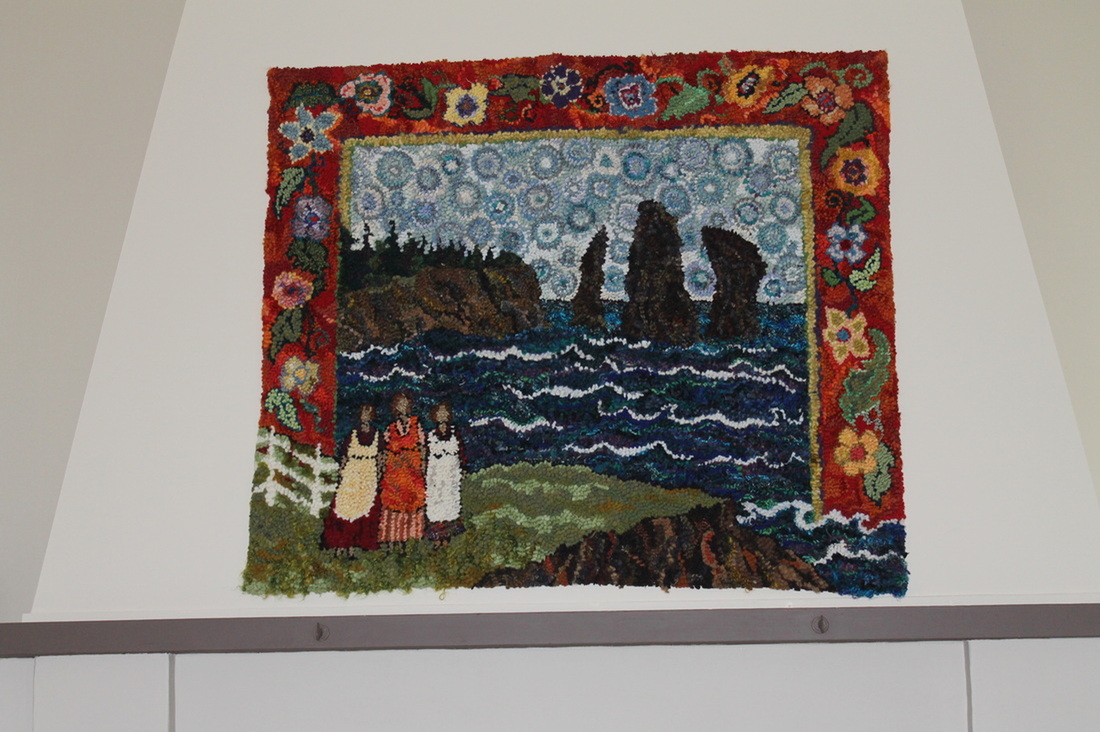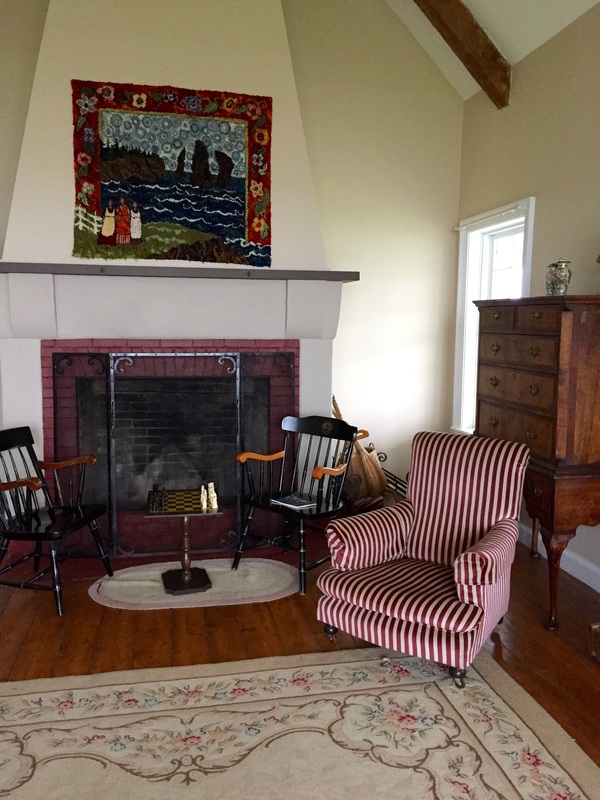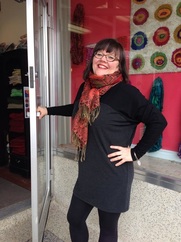CREDA purchased this lovely hooked rug from Deanne Fitzpatrick and they donated it to Thinkers Lodge.
Inspired by the rock formation in Cape Chignecto called the Three Sisters, Deanne Fitzpatrick, created this marvelous hooked rug showing the rocks and well as the human sisters of the legend.
Cape Chignecto Provincial Park, located in Advocate Harbour, Nova Scotia, rises above the Bay of Fundy and has 29 km (18 miles) of coastline. It is an area full of Mi'kmaq legend. One of the legends speaks of the Mi'kmaq God, Glooscap, who was moose hunting when his prey was chased off by three dogs. In retaliation Glooscap turned the three dogs into what is known as the Three Sisters and he made the moose immortal by turning him into "Isle Haute". It is the Three Sisters that first piqued my interest in the day hikes on Cape Chignecto's coastline.
Deanne Fitzpatrick describes herself on her website: I am a woman who lives on seven acres in an old farm house with wooden clapboard that is lifting in the wind. I walk five miles a day, most days, because it clears my head, and stretches out stiff limbs that have hunched over a rug frame.. I am alot of things in no particular order, a mother, sister, wife, artist, writer, teacher, reader, thinker, talker, friend, fool, dreamer, buddy. I am good at all of these. I am also terrible at all of these because sometimes I am being one of them when really I want to be one of the others. In my work the thing that matters most is making great rugs. I hook nearly everyday. I cannot stop myself. I like the feel of wool slipping through my fingers. I love working alone, though I had no idea that I would. It is a found pleasure, being alone, and it is one of my most favorite pleasues, being alone in the studio. I want to write more books. I want them to be both worthwhile and beautiful because writing is another thing I found that I liked to do. I dream that a small stack of books that I wrote myself will lay on my office shelf . I love land, especially fields. I find that a bunch of scrub and brush is a beautiful thing. It changes all day long with the light. I love the smell of fresh air on a person. It makes me want to hold them. I want to hang onto as simple a life as I possibly can. I do not find that easy because there are so many charms, that are like a ruby to a crow, but it is my goal to live simply, and make hooked rugs that are unmistakedly art.
I have a rug hooking studio in downtown Amherst, Nova Scotia where I show my one of a kind hooked rugs, create rug hooking kits, patterns, host workshops, and sell supplies. It is there in that warm colourful space that I write my books on rug hooking, and create designs for kits and patterns. It is a big creative space with a dye kitchen in the back where we transform old clothes and fancy wools into hooked rugs. We hand draw the rug patterns, and create the kits right there. I love to spend time there, touching the wool, making tea, and playing in that lovely space. It is a dream come true for me. I have written four books about rug hooking. We welcome visitors to the studio. If you drop in we'll teach how to hook rugs right on the spot, and send you off with a new passion for creating hooked rugs. If you cannot drop by, please peruse the site watch our videos so you can learn how to hook rugs.
Rug hooking is my passion. I grew up in Freshwater, Placentia Bay, Newfoundland, the youngest of seven children. My mother and both of my grandmothers hooked rugs as a past time, and as a chore of necessity. By the time I was born by my grandmothers had died and my mother had long since abandoned rug hooking as a chore of poverty. In Newfoundland in the late sixties, and early seventies very few people were hooking, though there was still a scattered mat hanging about peoples back doors. For the most part it was out with the old and in with the new. I can still see a Rita Murphy, my friends mother, sitting in her back room, hooking away on her mats. Her floors were a carpet of many multicoloured hooked rugs. At the time to me it seemed an old fashioned thing. Little did I know that I would spend years doing exactly the same thing.
I learned to hook rugs because I wanted rugs for an old farmhouse where I had settled. It began as a purely practical craft for me, and later turned into an art. Though I did not know how to hook, it was something I had always been familiar with. As a teenager, I began seeing rugs for what they were. I marvelled that a woman's' hand had pulled up every loop in a rug that lay on the floor of my sisters' farmhouse. In my mid twenties, I went to an annual meeting of The Rug Hooking Guild of Nova Scotia, and Marion Kennedy taught me the basics. How to cut your wool, and how to pull up a loop, then she told me to get to it. As soon as I started hooking rugs I knew it was for me. It was a simple technique, and I could see my progress. I finished my first little stamped pattern with in a week and so it began. For me, Marion was the right teacher. She gave me the supplies, showed me the basic stitch, and said, "Now do it, finish the rug." Her simple style of teaching made a huge difference in my learning. She did not try to direct me but let me learn as I hooked. I learned that I could tell stories, and express myself through rug hooking. This is what really got me involved with it. Each time I make a rug I create a new design. In many of my pieces I tell stories or express ideas about the world. I work full time as a rug hooking artist. Each piece I create is different from the last. I use recycled cloth, gather old wool clothing from real people in real communities. The clothes are washed, dried and torn apart. It is then hooked loop by loop on a a backing of burlap or linen.
I have a rug hooking studio in downtown Amherst, Nova Scotia where I show my one of a kind hooked rugs, create rug hooking kits, patterns, host workshops, and sell supplies. It is there in that warm colourful space that I write my books on rug hooking, and create designs for kits and patterns. It is a big creative space with a dye kitchen in the back where we transform old clothes and fancy wools into hooked rugs. We hand draw the rug patterns, and create the kits right there. I love to spend time there, touching the wool, making tea, and playing in that lovely space. It is a dream come true for me. I have written four books about rug hooking. We welcome visitors to the studio. If you drop in we'll teach how to hook rugs right on the spot, and send you off with a new passion for creating hooked rugs. If you cannot drop by, please peruse the site watch our videos so you can learn how to hook rugs.
Rug hooking is my passion. I grew up in Freshwater, Placentia Bay, Newfoundland, the youngest of seven children. My mother and both of my grandmothers hooked rugs as a past time, and as a chore of necessity. By the time I was born by my grandmothers had died and my mother had long since abandoned rug hooking as a chore of poverty. In Newfoundland in the late sixties, and early seventies very few people were hooking, though there was still a scattered mat hanging about peoples back doors. For the most part it was out with the old and in with the new. I can still see a Rita Murphy, my friends mother, sitting in her back room, hooking away on her mats. Her floors were a carpet of many multicoloured hooked rugs. At the time to me it seemed an old fashioned thing. Little did I know that I would spend years doing exactly the same thing.
I learned to hook rugs because I wanted rugs for an old farmhouse where I had settled. It began as a purely practical craft for me, and later turned into an art. Though I did not know how to hook, it was something I had always been familiar with. As a teenager, I began seeing rugs for what they were. I marvelled that a woman's' hand had pulled up every loop in a rug that lay on the floor of my sisters' farmhouse. In my mid twenties, I went to an annual meeting of The Rug Hooking Guild of Nova Scotia, and Marion Kennedy taught me the basics. How to cut your wool, and how to pull up a loop, then she told me to get to it. As soon as I started hooking rugs I knew it was for me. It was a simple technique, and I could see my progress. I finished my first little stamped pattern with in a week and so it began. For me, Marion was the right teacher. She gave me the supplies, showed me the basic stitch, and said, "Now do it, finish the rug." Her simple style of teaching made a huge difference in my learning. She did not try to direct me but let me learn as I hooked. I learned that I could tell stories, and express myself through rug hooking. This is what really got me involved with it. Each time I make a rug I create a new design. In many of my pieces I tell stories or express ideas about the world. I work full time as a rug hooking artist. Each piece I create is different from the last. I use recycled cloth, gather old wool clothing from real people in real communities. The clothes are washed, dried and torn apart. It is then hooked loop by loop on a a backing of burlap or linen.



